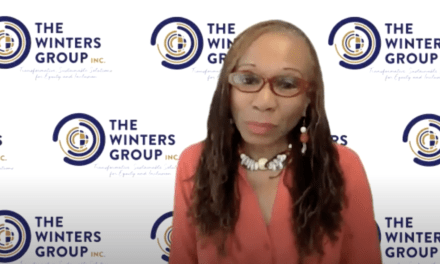Since the murder of George Floyd last May, many organizational leaders have found themselves in deeply unfamiliar territory. Most recognized that the mobilization of protesters across the world represented a call for leaders to speak up about racial justice. Many released statements expressing solidarity — then were surprised to find their employees were unsatisfied without commitment to action. Some committed to action, but then were not sure how to follow-through, or allowed other priorities to take precedent as time passed. Employees began expressing frustration at lack of follow-through, and have more recently been resigning in record numbers as a result of workplace dissatisfaction. Customers prompted boycotts that spread quickly on social media after disappointing demonstrations of commitment to racial justice from organizational leaders.
For executives further along in their equity and inclusion journey, recent events and today’s socio-political climate may be prompting a question they are not accustomed to grappling with — particularly if they have faced relatively few barriers to career advancement: “Am I qualified for this role?”
For executives in their equity and inclusion journey, today’s socio-political climate may be prompting a question they are not accustomed to: 'Am I qualified for this role?' Share on XIn August of 1984, The Wall Street Journal published a story entitled “Many Blacks Jump Off The Corporate Ladder: Feeling Their Rise Limited.” In 2019, The New York Times published a strikingly similar headline: “Study Examines Why Black Americans Remain Scarce in Executive Suites.” Black Americans did not need another study to confirm what was readily apparent to them; as the New York Times article affirmed: “… while most black professionals are keenly aware of inequities that slow their advancement, many of their white peers are largely ignorant of them.”
While affirmative action policies aimed to address such inequities, opponents of these measures steadfastly framed them as an attack on neutrality, and a way to usher in employees who are “not the most qualified” applicants for their roles. To the contrary, persistent overrepresentation of white people in professional settings is anything but neutral. (What’s more, a reminder that always bears repeating: white women have been the primary beneficiaries of affirmative action policies.)
While affirmative action is aimed to address inequities, opponents of it frame it as an attack on neutrality. To the contrary, persistent overrepresentation of white people in professional settings is anything but neutral. Share on XThe consequences of white cultural norms and worldviews being falsely assumed as neutral are increasingly apparent as white executives publicly struggle with their areas of limited perspective and fail to respond to the needs of their Black and Brown stakeholders. To put it plainly, the ability to understand and work effectively with others across cultural differences is a critical skill; lacking it ought to be seen as an underqualification for anyone tasked with leading a racially (and otherwise) diverse workforce. It is a result of white supremacy that it has not always been understood that way.
Ability to work across cultural differences is a critical skill; lacking it ought to be an underqualification for those leading a diverse workforce. It is a result of white supremacy that this has not always been understood. Share on XWe used to frequently cite a study in our sessions that found that teams headed by culturally competent leaders (who understand and value the differences their team members bring) outperform both diverse teams headed by culturally incompetent leaders, and homogenous teams. We have since strayed from citing this research, as we have found that the so-called “business case for diversity” emphasizes profit over people in ways that harm this work. However, in industries as varied as art, tech, and retail to name just a few, consequences of recent decisions that disproportionately harmed Black, Indigenous, and other people of color have been amplified by collective action and social media in ways that make them impossible to ignore — because they hit organizations in the pocketbook. The reality of the situation, what I refer to as the “new business case for equity and inclusion,” is that in today’s world, those leaders who do not prioritize developing the skills necessary to both attract and continue to support a diverse workforce will inevitably face negative consequences. If it hasn’t happened yet, it is only a matter of time.
Leaders who do not prioritize developing the skills necessary to attract and continue to support a diverse workforce will inevitably face negative consequences. If it hasn’t happened yet, it is only a matter of time Share on XIn a recent post, my colleague Tami Jackson highlighted a model that is critical to understanding one dynamic at play on diverse teams: “Peace Over Truth vs. Truth Over Peace.” This research-based model affirms that culturally, many white people tend to avoid conflict or agree to disagree as a way of keeping peace. Conversely, many Black people tend to surface and address conflict directly, even if it is uncomfortable.
On an organizational level, one specific way we have seen this dynamic surface repeatedly is leaders hiring DEI firms to address their DEI challenges … then canceling contracts when, from their perspective, the work gets uncomfortable or messy. On one level, this makes sense — having never navigated this work, predominantly white leaders are lulled by a false sense of security in Peace Over Truth. However, those of us immersed in this work know that it is only a matter of time before tensions boil over. Some of these same organizations have returned to us later, recognizing that they could not pave over the entrenched issues that risk amplification and public scrutiny.
I would remind leaders that, as unsettling as constructive feedback from employees may feel, your employees are giving you a gift by sharing the truths of their experiences and needs. What you do with this information is up to you, but writing it off as unrealistic or unimportant is no longer a viable option. If you look around your executive offices and board rooms and realize that everyone looks like you and no one has the skills to respond to this feedback, it is past time to change that. Contracting education or one-on-one coaching is a good place to start; ultimately, however, your leadership should represent the diversity of your workforce, and this must become a priority.
As unsettling as constructive feedback from employees may feel, it's a gift to receive the truths of their experiences. What you do with this is up to you, but writing it off as unrealistic or unimportant is no longer an option. Share on XI will leave you with five key Leadership Commitments that The Winters Group has outlined for clients we work with:
- Recognize that systemic inequity, injustice, and exclusion are real and exist everywhere.
- Know you are responsible and accountable for creating and sustaining equity and justice.
- Be willing to engage in your own reflection and learning, recognizing personal work is necessary to drive broader change.
- Prioritize and allocate ample resources to sustain this work.
- Accept resistance, conflict, and discomfort as requisite to progress.




















